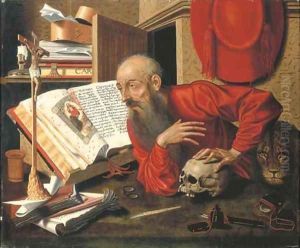Marinus Van Reymerswael Paintings
Marinus van Reymerswaele was a Dutch Renaissance painter whose work offers a window into the societal and economic concerns of the 16th century. Born around 1490 in the town of Reimerswaal, from which he derived his name, Marinus was part of the Northern Renaissance, a period marked by a profound interest in realism, detail, and the secular world. Although the exact details of his life are somewhat obscure, it is known that he was active in the art scene from the early 1520s until the mid-16th century, with the majority of his known works dated to the 1530s and 1540s.
Marinus specialized in genre scenes, particularly those depicting money changers, tax collectors, and lawyers, through which he explored themes of morality, avarice, and hypocrisy. His paintings are characterized by their meticulous detail, vivid realism, and often, a satirical undercurrent that critiqued the greed and corruption he perceived in society. The influence of Hieronymus Bosch, known for his fantastical imagery and moralistic themes, is evident in Marinus's work, although Marinus's approach was more grounded in everyday reality.
One of his most famous works, 'The Money Changer and His Wife', vividly illustrates his skill in rendering textures and materials, as well as his keen observation of human character and interaction. This painting, like many of his others, serves as a moral warning against the perils of avarice and materialism, a common theme in the art and literature of the period.
Despite his focus on the darker aspects of human nature, Marinus's work was highly valued for its technical skill and intricate detail. His ability to capture the nuances of facial expressions and domestic interiors made his paintings a valuable document of his times. However, after his death, which is estimated to have occurred around 1567, Marinus van Reymerswaele's name faded into relative obscurity, overshadowed by other Renaissance masters. It was not until the 19th and 20th centuries that art historians began to reassess his contribution to the Northern Renaissance, recognizing him as a significant figure in the development of Dutch genre painting.
Today, Marinus van Reymerswaele remains known for his keen social commentary and mastery of detail, representing an important but often overlooked voice in the tapestry of Renaissance art. His works are preserved in some of the world's leading museums, where they continue to fascinate viewers with their insight into 16th-century life and culture.
